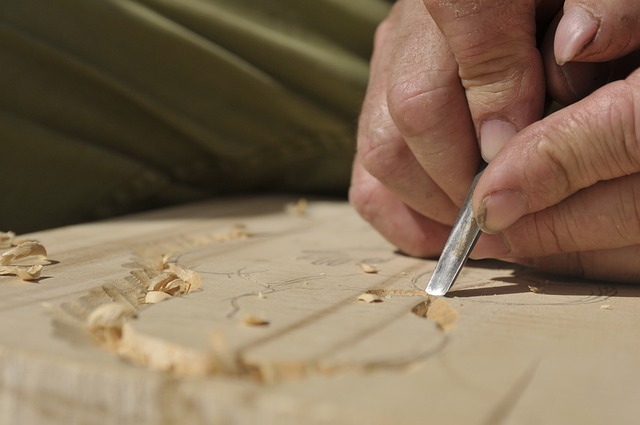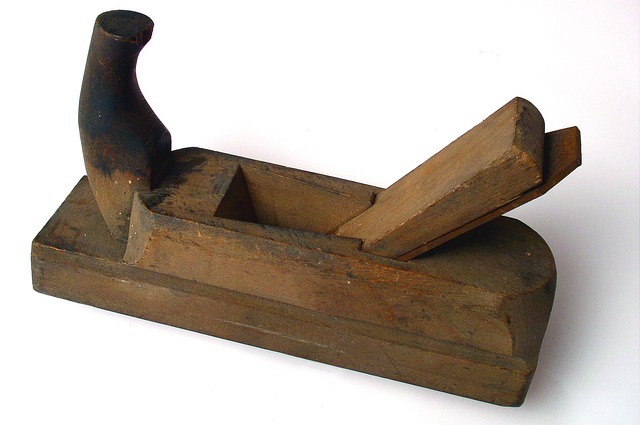A skilled carpenter expertly bridges traditional craftsmanship with modern innovation, mastering a range of joinery techniques like mortise and tenon, dovetail, and through tenons to create durable, aesthetically pleasing wood projects. This artisan selects materials carefully, uses precision tools such as chisels and saws for accurate cutting, and applies extensive knowledge to navigate challenges, ensuring joints are both robust and visually appealing. The evolution of joinery spans millennia, from early civilizations' basic notches and mortises to the sophisticated joints of the Renaissance, enhanced by the Industrial Revolution's power tools and continuing today with advanced machinery that maintains the integrity of traditional methods while offering new possibilities in design. Carpenters now blend historical techniques with contemporary technology to produce joinery for restoration projects and innovative architectural elements, highlighting the enduring importance of this craft. The resurgence of interest in sustainable, high-quality construction has brought renewed focus on traditional joinery, showcasing its relevance in both preserving historical craftsmanship and influencing modern design. Key tools like tenon saws, chisels, combination squares, planes, marking gauges, bevel gauges, and sharp drill bits are essential for a carpenter's precision work, ensuring that each piece reflects the carpenter's skill and artistry. Joinery not only enhances the structural integrity of wooden pieces but also showcases the natural beauty of the wood, underscoring the carpenter's mastery over both technical and artistic aspects of their trade.
Embark on a journey through the intricate world of complex joinery, where the timeless craftsmanship of carpenters meets the demands of modern design. This article delves into the nuances of mastering this art form, tracing the evolution of joinery techniques from traditional methods to contemporary applications. Explore the essential tools and wood types that carpenters use to achieve intricate joints, understand the different types of joinery integral to woodworking, and appreciate the balance of tradition with contemporary aesthetics in design principles. From the precision required in complex carpentry projects to the role of CNC technology in modern craftsmanship, each section unravels a facet of this versatile skill. Join us as we celebrate the carpenter’s art, highlighting how joinery serves as a testament to both functionality and beauty in furniture making, home construction, and more.
- Mastering Complex Joinery: The Expertise of a Skilled Carpenter
- The Evolution of Joinery Techniques Through Time
- Traditional Joinery Methods and Their Modern Applications
- Essential Tools for Crafting Intricate Joinery
- Understanding Different Types of Joinery in Woodworking
Mastering Complex Joinery: The Expertise of a Skilled Carpenter

A carpenter with proficiency in complex joinery stands at the intersection of tradition and innovation, blending time-honored techniques with modern design principles to produce intricate wooden structures. The intricacies of this craft demand a deep understanding of various joint types, from mortise and tenon to dovetail and through tenon joinery, each serving distinct structural functions and aesthetic purposes within the framework. The process begins with careful selection and preparation of raw materials, followed by precise cutting and assembly that often involves specialized tools such as chisels, saws, and planes. This meticulous work ensures the longevity and integrity of the joinery, making it a critical aspect of high-quality woodworking.
The expertise of such a carpenter is not only evident in the final product but also in the thoughtful execution of each step. They anticipate potential challenges, adapt to variations in material, and apply their knowledge to overcome obstacles that arise during the joinery process. This adaptability and skill set are crucial for tackling the complex geometry and tight tolerances demanded by contemporary designs, which often push the boundaries of traditional techniques. The result is a testament to the carpenter’s dedication to mastering the art of joinery, producing pieces that are both functional and aesthetically pleasing, with joints that stand the test of time.
The Evolution of Joinery Techniques Through Time

Craftsmanship in joinery has been a cornerstone of carpentry for millennia, with techniques evolving to meet the changing demands of architecture and design. Initially, early carpenters employed simple notches and mortises to assemble structures from locally sourced materials. As civilizations advanced, so did their joinery methods, with ancient Egyptian and Greek builders developing more sophisticated interlocking joints that were both strong and aesthetically pleasing. The introduction of new tools and materials over the centuries, such as iron chisels and saws, facilitated intricate woodworking techniques, allowing for tighter fits and stronger connections in joinery.
The Middle Ages saw a significant advancement with the invention of the pit saw and the sawpit, enabling longer and more precise timber cuts, which were critical for constructing large wooden buildings like cathedrals and castles. By the Renaissance, Italian carpenters refined joinery to an art form, creating pieces that showcased both structural integrity and elegance. The Industrial Revolution brought about machine-driven precision, revolutionizing joinery once again. Innovations such as power saws, drills, and planers have allowed modern carpenters to create complex joinery for both traditional designs and contemporary architectural elements with unprecedented efficiency and accuracy. Today, the art of joinery is a testament to the evolution of craftsmanship, blending time-honored techniques with modern technology to produce work that spans from restoration projects to cutting-edge designs in architecture and furniture making.
Traditional Joinery Methods and Their Modern Applications

Craftspeople have long utilized traditional joinery methods to create intricate and durable connections in woodworking, a practice that remains integral to both preserving historical craftsmanship and innovating within contemporary design. These time-honored techniques, such as mortise and tenon, dovetail, and through tenons, are the bedrock upon which carpenters build their projects, ensuring strength, alignment, and visual appeal. The precision of these methods is not merely a product of historical necessity but also a testament to the enduring nature of their application in modern contexts. Today’s carpenters, blending tradition with technology, employ these joinery techniques to construct everything from antique reproductions to cutting-edge architectural designs. The resurgence of interest in sustainable and high-quality construction has brought renewed focus on the artistry and functionality inherent in traditional joinery, making it a cornerstone of both restoration projects and modern builds alike. As such, the role of the carpenter in interpreting these methods for new applications is crucial, as they navigate the balance between honoring historical techniques and meeting the demands of modern design.
Essential Tools for Crafting Intricate Joinery

When a carpenter embarks on crafting intricate joinery for both traditional and modern designs, the precision and finesse of their work are paramount. The essence of intricate joinery lies in its ability to interlock pieces seamlessly, creating structures that are both aesthetically pleasing and functionally sound. To achieve this level of craftsmanship, a carpenter relies on a suite of essential tools that enable them to measure, cut, shape, and assemble wood with exceptional accuracy. Among these indispensable tools are the tenon saw, chisels of various sizes, a combination square, and a high-quality set of planes. The tenon saw’s fine teeth allow for precise cuts necessary for joinery like tenons and mortises, which are foundational to many joint types. Chisels are used to carve out the precise fit areas, with larger chisels removing bulk material and smaller ones refining the fit. A combination square is crucial for ensuring that angles and lines are true to form, while a set of planes can smooth and flatten surfaces to perfection. Additionally, a high-quality bench vise is essential for holding work securely during sawing, chiseling, or planing. Other tools like a marking gauge, a bevel gauge, and a set of sharp drill bits are also vital for creating consistent and repeatable joints. A carpenter’s understanding of the material properties of wood and the correct application of these tools is what transforms raw timber into beautiful, complex joinery that stands as a testament to their skill. With these tools in hand, a carpenter can produce joinery that not only withstands the test of time but also adds a touch of artistry to every project they undertake.
Understanding Different Types of Joinery in Woodworking

Crafting intricate wood pieces that stand the test of time requires a deep understanding of joinery techniques, a skill honed by generations of carpenters. Joinery refers to the method of joining pieces of wood together without the use of metal fasteners, relying instead on the interlocking of wood surfaces. This practice not only enhances the structural integrity of the piece but also showcases the beauty of the material itself. A carpenter adept in this art can select from a variety of joinery types to suit both traditional and modern designs. For instance, dovetail joints, with their interlocking triangles, are a staple in drawers and chests for their strength and aesthetics. Mortise and tenon joints, on the other hand, are critical for assembling frames and legs of furniture due to their ability to transfer loads efficiently. These are just two examples of the many joinery techniques that carpenters utilize to create functional and durable pieces. Understanding the nuances of each type is essential for choosing the right joint for the project at hand, whether it’s an antique-inspired sideboard or a sleek, contemporary design. The precision and craftsmanship required in executing these joineries are testaments to the skill level of a professional carpenter, who combines both technical knowledge and artistic flair to achieve the desired outcome.
Craftsmanship and innovation intertwine beautifully in the realm of joinery, as evidenced by the enduring tradition and contemporary advancements showcased by skilled carpenters. The art of creating complex joinery is a testament to human ingenuity and precision, serving both functional and aesthetic purposes across various design applications. From the mastery of traditional methods to the integration of modern techniques, the evolution of joinery underscores the adaptability of this craft. Carpenters who excel in this specialized field possess not only a deep understanding of the essential tools required but also an appreciation for the different types of joinery that enhance both traditional and contemporary designs. As the article has outlined, the journey through the history, techniques, and applications of joinery offers insight into how this craft continues to thrive and inspire new generations of carpenters.
